First seeing Rousham
Rousham was the last of many gardens I visited in May as a member of Carolyn Mullet's spring tour of English gardens and the Chelsea Flower Show. Rousham was the only eighteenth century landscape garden on the tour. In that sense, it appeared to be an outlier, but it turned out to be a key to understanding all the gardens we had seen.
 How should one visit a garden? I had imagined I'd be alone on my first visit to Rousham and, surprisingly, I was. Our tour group quickly dissipated in its vast space and hidden, shaded pathways. So I wandered mostly alone, but I had a mission: to match what I had read about Rousham with the garden's geography. I wanted an interior map, to know how all the pieces fit together.As to my personal thoughts and feelings on first seeing Rousham, I wasn't alone at all. I had Dan Pearson and Tim Richardson at my elbow. My experience was filtered through my reading, so I'll quote directly from Dan Pearson's Spirit: Garden Inspiration and Tim Richardson's The Arcadian Friends, both of which I recommend to you. Dan Pearson: "Rousham is restful, spacious, timeworn and beautifully paced and whatever season you visit, the garden always reveals something afresh. Charles Bridgeman's design for the gardens was originally completed in 1737 and shortly afterwards General James Dormer commissioned William Kent to further enhance and carry forward the garden. It is remarkable for the fact that it has remained in the same family since then and it is one of the first landscape-gardens to blur the boundaries between the garden and the pastoral English countryside beyond."
How should one visit a garden? I had imagined I'd be alone on my first visit to Rousham and, surprisingly, I was. Our tour group quickly dissipated in its vast space and hidden, shaded pathways. So I wandered mostly alone, but I had a mission: to match what I had read about Rousham with the garden's geography. I wanted an interior map, to know how all the pieces fit together.As to my personal thoughts and feelings on first seeing Rousham, I wasn't alone at all. I had Dan Pearson and Tim Richardson at my elbow. My experience was filtered through my reading, so I'll quote directly from Dan Pearson's Spirit: Garden Inspiration and Tim Richardson's The Arcadian Friends, both of which I recommend to you. Dan Pearson: "Rousham is restful, spacious, timeworn and beautifully paced and whatever season you visit, the garden always reveals something afresh. Charles Bridgeman's design for the gardens was originally completed in 1737 and shortly afterwards General James Dormer commissioned William Kent to further enhance and carry forward the garden. It is remarkable for the fact that it has remained in the same family since then and it is one of the first landscape-gardens to blur the boundaries between the garden and the pastoral English countryside beyond."  Only in retrospect do I ask myself what would one do on a return visit, after becoming familiar with the layout and topography, and given time to appreciate the garden's subtler points and vanishingly beautiful design, which I did see in spite of my busyness.
Only in retrospect do I ask myself what would one do on a return visit, after becoming familiar with the layout and topography, and given time to appreciate the garden's subtler points and vanishingly beautiful design, which I did see in spite of my busyness.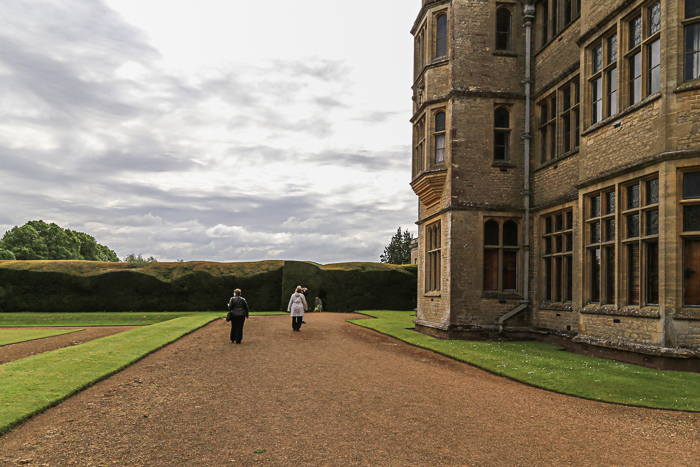
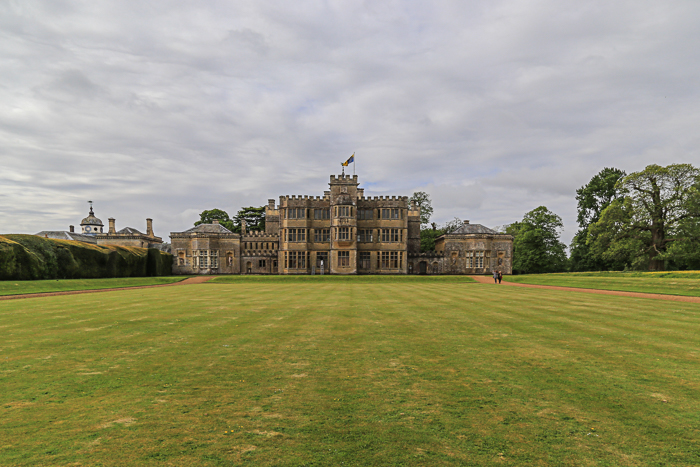 Dan Pearson: "... a formal lawn is dropped slightly below a mossy gravel apron from which the facade of the house rises without hesitation. The views out and over the land below introduce you to the connection with the landscape and, although they set the scene for the informality beyond, the lawns in front of you are the most formal element that you are to experience. The ground in front of the house is spare. There are no borders, the building meets gravel. The gravel is mossy in the shade and crunchy out in the sun, where it moves away to frame the formal lawn." William Kent’s background in architecture, and in interior and theatrical design, was clearly evident in subtle manipulations of atmosphere and space. First off was what he chose to keep of Charles Bridgeman’s original design—the grand, expansive bowling green spreading out from the grand and somber house, a formal, though simple space, completely empty, that allows time to prepare for other more intimate experiences to come. The house, seemingly immense, rests on an austere and extremely flat plane, with no plantings around it--such restraint making the buildings and green expanse all the more starkly effective, making the human form appear to be insignificant in this vast scale (you can see two of my tour mates almost invisible on the right path).Once away from this grand space, however, that relationship is reversed, and the human scale becomes the focus of the Rousham experience.
Dan Pearson: "... a formal lawn is dropped slightly below a mossy gravel apron from which the facade of the house rises without hesitation. The views out and over the land below introduce you to the connection with the landscape and, although they set the scene for the informality beyond, the lawns in front of you are the most formal element that you are to experience. The ground in front of the house is spare. There are no borders, the building meets gravel. The gravel is mossy in the shade and crunchy out in the sun, where it moves away to frame the formal lawn." William Kent’s background in architecture, and in interior and theatrical design, was clearly evident in subtle manipulations of atmosphere and space. First off was what he chose to keep of Charles Bridgeman’s original design—the grand, expansive bowling green spreading out from the grand and somber house, a formal, though simple space, completely empty, that allows time to prepare for other more intimate experiences to come. The house, seemingly immense, rests on an austere and extremely flat plane, with no plantings around it--such restraint making the buildings and green expanse all the more starkly effective, making the human form appear to be insignificant in this vast scale (you can see two of my tour mates almost invisible on the right path).Once away from this grand space, however, that relationship is reversed, and the human scale becomes the focus of the Rousham experience. The immense bowling green flowing out from the house extends the view into the distance, to a dramatic sculptural focal point, then across a sudden and invisible drop in elevation to the distant countryside beyond, hiding for the moment any view of the River Cherwell, which meanders quietly below and marks Rousham's boundary. The landscape in the distance is outside the garden, though Kent went to some trouble to make that more distant view appear to be part of the garden, the classic "borrowed view."
The immense bowling green flowing out from the house extends the view into the distance, to a dramatic sculptural focal point, then across a sudden and invisible drop in elevation to the distant countryside beyond, hiding for the moment any view of the River Cherwell, which meanders quietly below and marks Rousham's boundary. The landscape in the distance is outside the garden, though Kent went to some trouble to make that more distant view appear to be part of the garden, the classic "borrowed view."
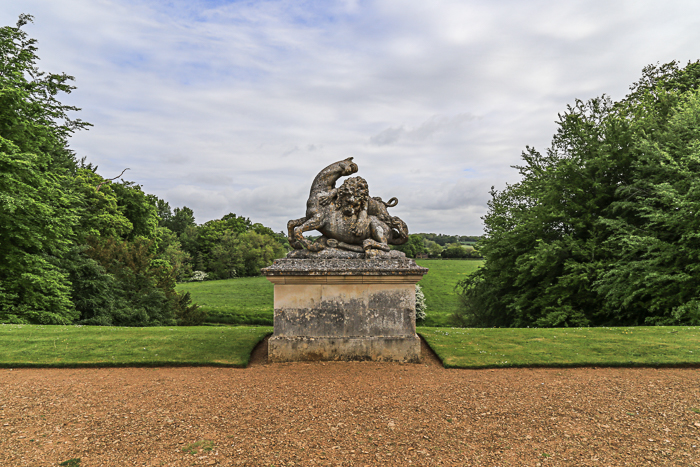 Tim Richardson: "This is an exceptionally savage tableau, with the lion sinking its jaws into the back of the screaming and collapsing steed. It creates a note of tension right at the start of one's journey through the landscape, a violent confrontation silhouetted starkly against the landscape of agricultural fields seen beyond the end of the smooth, empty bowling green behind the house ...""In a strikingly managed example of a 'borrowed landscape', Kent effectively extended the boundaries of the estate--which is comparatively modest in acreage--by customizing an existing building, Cuttle Mill (in the middle distance), with a modest Gothick gable end and other decoration, and by placing a three-arched eyecatcher on the brow of the most distant hill. The statues and temples within the garden are mainly classical in theme and style, while these more distant buildings are Gothick and therefore ancient and English. So perhaps it was not so much a case of Kent extending the imagery of nymphs and deities into the surrounding countryside, but of his trying to convince us that we have indeed entered a mythic plane, a parallel world, where the 'normality' beyond the estate's boundary is in fact an English Gothick domain of goblins and faeries."When you encounter the violence of the sculpture, you wonder what was William Kent's intent in commissioning this work for this central place in the garden.My impression is that it is like a theatrical thunderclap announcing the opening of a drama. It catches your attention with a dramatic flourish--think of the bravura overture to an opera--then passively waits for you to find the next stage in the unfolding drama, a dark path into the woods off to the left of this central scene. This obscure path is, in fact, the entry point into the "real" Rousham, a naturalistic garden, all curves opening to views of hidden delights, lawns and woodland, light and shadow, temples, statues, rills and pools and, of course, gently brushing its edge below, the River Cherwell.
Tim Richardson: "This is an exceptionally savage tableau, with the lion sinking its jaws into the back of the screaming and collapsing steed. It creates a note of tension right at the start of one's journey through the landscape, a violent confrontation silhouetted starkly against the landscape of agricultural fields seen beyond the end of the smooth, empty bowling green behind the house ...""In a strikingly managed example of a 'borrowed landscape', Kent effectively extended the boundaries of the estate--which is comparatively modest in acreage--by customizing an existing building, Cuttle Mill (in the middle distance), with a modest Gothick gable end and other decoration, and by placing a three-arched eyecatcher on the brow of the most distant hill. The statues and temples within the garden are mainly classical in theme and style, while these more distant buildings are Gothick and therefore ancient and English. So perhaps it was not so much a case of Kent extending the imagery of nymphs and deities into the surrounding countryside, but of his trying to convince us that we have indeed entered a mythic plane, a parallel world, where the 'normality' beyond the estate's boundary is in fact an English Gothick domain of goblins and faeries."When you encounter the violence of the sculpture, you wonder what was William Kent's intent in commissioning this work for this central place in the garden.My impression is that it is like a theatrical thunderclap announcing the opening of a drama. It catches your attention with a dramatic flourish--think of the bravura overture to an opera--then passively waits for you to find the next stage in the unfolding drama, a dark path into the woods off to the left of this central scene. This obscure path is, in fact, the entry point into the "real" Rousham, a naturalistic garden, all curves opening to views of hidden delights, lawns and woodland, light and shadow, temples, statues, rills and pools and, of course, gently brushing its edge below, the River Cherwell. Once you enter this path, there is a quietude and stillness about Rousham, and carefully placed classical features, that intentionally recall the antiquity of the Augustan Age, for Rousham was most definitely envisioned as a reawakening and recreation of the spirit of that Roman age of enlightenment. (William Kent was a close friend of Alexander Pope, was well schooled in Roman art, the antique Italian landscape and gardens, and he sprinkled Rousham with numerous architectural and sculptural allusions to this golden age so emulated in 18th century England.)Nowhere about Rousham does one find the riot of plantiness, the studied, self-consciously "arranged plantings" of so many English gardens of more recent vintage--the planted garden rooms of Arts-and-Crafts gardens, for example. Rousham is the great progenitor of the English Landscape Garden, and recognized for being one of the first gardens to open itself to the surrounding countryside. Capability Brown would come after, and would do much more to wed landscape and garden, though perhaps not as well as Kent, depending on your own taste.
Once you enter this path, there is a quietude and stillness about Rousham, and carefully placed classical features, that intentionally recall the antiquity of the Augustan Age, for Rousham was most definitely envisioned as a reawakening and recreation of the spirit of that Roman age of enlightenment. (William Kent was a close friend of Alexander Pope, was well schooled in Roman art, the antique Italian landscape and gardens, and he sprinkled Rousham with numerous architectural and sculptural allusions to this golden age so emulated in 18th century England.)Nowhere about Rousham does one find the riot of plantiness, the studied, self-consciously "arranged plantings" of so many English gardens of more recent vintage--the planted garden rooms of Arts-and-Crafts gardens, for example. Rousham is the great progenitor of the English Landscape Garden, and recognized for being one of the first gardens to open itself to the surrounding countryside. Capability Brown would come after, and would do much more to wed landscape and garden, though perhaps not as well as Kent, depending on your own taste. To use a metaphor for its emotional effect, Rousham is like a single, bare armature onto which one might wind thoughts and feelings that arise on visiting the garden. But what kinds of thoughts and feelings? It seems to offer a "negative capability," become an empty vessel into which you can pour whatever emotions arise. It's quite austere. Intensely quiet, so quiet you easily hear the chickens making chicken noises in the unadorned entry courtyard. Can you imagine a scene such as this one, with rustic, wooden chicken coops in one of the great English landscape gardens? Rousham is owned and lived in my the descendents of the same family that occupied the house when William Kent began making the garden in the 1730s. What a wonderful statement of intent to "keep it simple."Rousham makes you want to be silent, or speak softly.
To use a metaphor for its emotional effect, Rousham is like a single, bare armature onto which one might wind thoughts and feelings that arise on visiting the garden. But what kinds of thoughts and feelings? It seems to offer a "negative capability," become an empty vessel into which you can pour whatever emotions arise. It's quite austere. Intensely quiet, so quiet you easily hear the chickens making chicken noises in the unadorned entry courtyard. Can you imagine a scene such as this one, with rustic, wooden chicken coops in one of the great English landscape gardens? Rousham is owned and lived in my the descendents of the same family that occupied the house when William Kent began making the garden in the 1730s. What a wonderful statement of intent to "keep it simple."Rousham makes you want to be silent, or speak softly.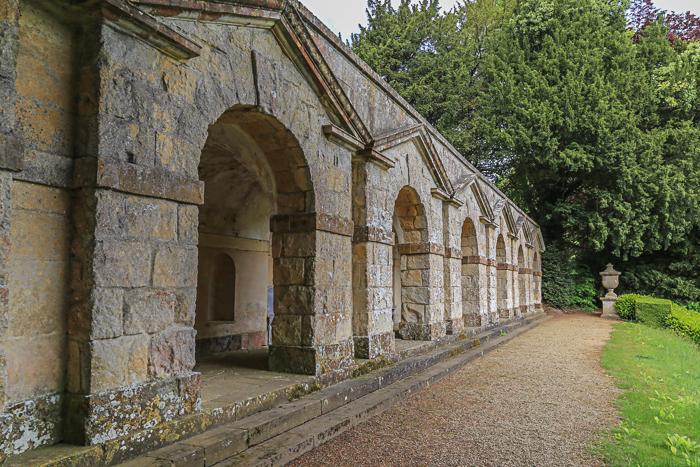 Tim Richardson: "Perhaps the single most satisfying feature at Rousham is the arcade called Praeneste, named after the much-visited Roman ruin which Kent would have known first hand ... Praeneste marks the transition between the austere bowling green and the mythic woodland below, with good views down to the river." For me, Rousham was a key to understanding all of the many gardens we visited, because at Rousham William Kent established the British landscape garden as a governing type for the next two centuries. In Horace Walpole's words, "He leapt the fence and saw all nature was a garden"--an exaggeration, perhaps, but one that makes the point in memorable words.What followed much later was reaction to this "English Landscape Garden," which Capability Brown would push to the max. Most of the other gardens we visited, many extremely well known, such as Hidcote and Great Dixter and Sissinghurst, exemplify the "garden room" structure so typical of Arts-and-Crafts gardens, and many of them almost completely turn their backs on the outside landscape (of course, with exceptions).So our tour of gardens became, for me, a kind of meditation on how gardens are opened and closed to their surroundings, and by extension, how gardens use artifice to create the illusion of various modes of what we might call "the natural." On the coach ride back to our hotel, lines from a poem that puts this open-closed-open metaphor to powerful use came to mind, and I looked the poem up immediately on our return. It is by Yehuda Amichai, and I admit it may say more about how I see gardens than about gardens themselves:
Tim Richardson: "Perhaps the single most satisfying feature at Rousham is the arcade called Praeneste, named after the much-visited Roman ruin which Kent would have known first hand ... Praeneste marks the transition between the austere bowling green and the mythic woodland below, with good views down to the river." For me, Rousham was a key to understanding all of the many gardens we visited, because at Rousham William Kent established the British landscape garden as a governing type for the next two centuries. In Horace Walpole's words, "He leapt the fence and saw all nature was a garden"--an exaggeration, perhaps, but one that makes the point in memorable words.What followed much later was reaction to this "English Landscape Garden," which Capability Brown would push to the max. Most of the other gardens we visited, many extremely well known, such as Hidcote and Great Dixter and Sissinghurst, exemplify the "garden room" structure so typical of Arts-and-Crafts gardens, and many of them almost completely turn their backs on the outside landscape (of course, with exceptions).So our tour of gardens became, for me, a kind of meditation on how gardens are opened and closed to their surroundings, and by extension, how gardens use artifice to create the illusion of various modes of what we might call "the natural." On the coach ride back to our hotel, lines from a poem that puts this open-closed-open metaphor to powerful use came to mind, and I looked the poem up immediately on our return. It is by Yehuda Amichai, and I admit it may say more about how I see gardens than about gardens themselves:
Open closed open. Before we are born, everything is openin the universe without us. For as long as we live, everything is closedwithin us. And when we die, everything is open again.Open closed open. That’s all we are.
The distance between this poem and Rousham, a garden, may seem a wide leap for some. I see all gardens as very much about life, about death, about memory, and about meaning. The experience of Rousham was a metaphor of opening and closing and opening again, moving from dark to light, light to dark, punctuated by temples, statues, pools and other ornaments and devices that marked and shaped the experience.This image of the famous rill and bathing pool below shows how Kent created a sense of closure with shadow and the openness with light. This scene has a powerful presence, an immanence, though it's essentially empty.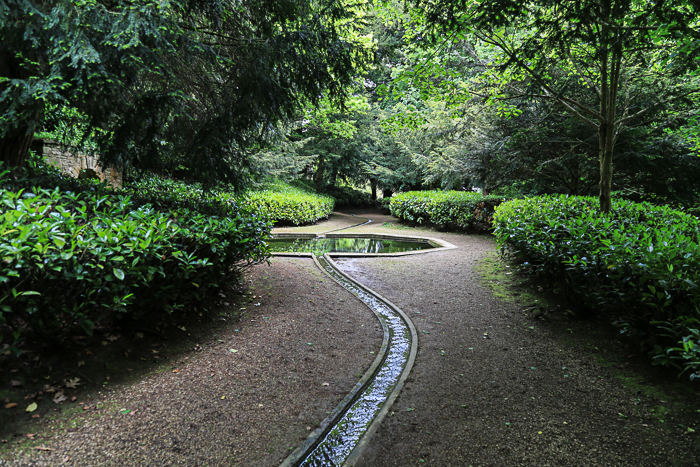 Note the subtle changes in light on the surface of the gravel path, the reflections in the water, the glowing light in the space around the bathing pool.
Note the subtle changes in light on the surface of the gravel path, the reflections in the water, the glowing light in the space around the bathing pool.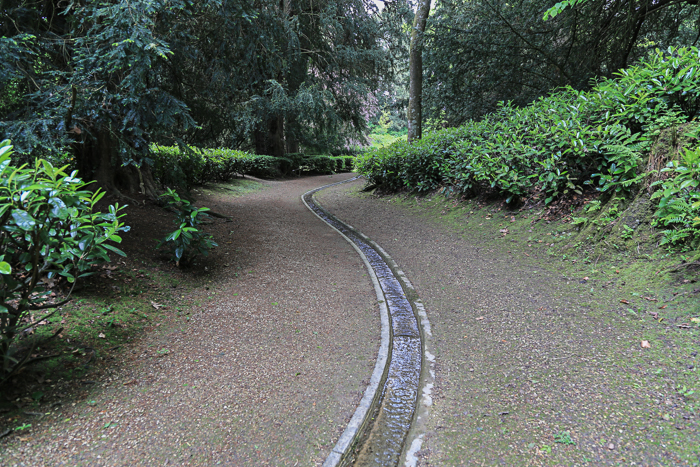 Dan Pearson: "The rill ... is supremely minimal, like a rivulet in a wood but drawn, like a pencil line into this landscape. The sliver of water snakes away and draws you into the trees. It is completely modern and timeless. Dark yews cast shadows so that the water in the rill glimmers as it picks up the light. The water is green under the canopy but silver where it emerges into the open and you follow it as it murmurs towards a break in the cover. Emerald green laurel lightens the mood around a bathing pool where the water slows and is held still before moving on. It is completely enticing and you want to strip and plunge to feel the water on your skin. The octagonal form is unexpected and it formalises this clearing for a moment. You move on into the darkness again as the path snakes through the arc of foliage that frames the walkway.You can never see the whole rill at once. The silence is only broken when you emerge into light and the rill drops into the still of the lily pond. This is the first sound of running water, a contrast to the silence of the river, and an echo is held in the bowl of the hill ...You rest here to take in the soft depression at the head of the little valley. Your walk unfolds in your mind's eye whilst you ponder whether you want to make your way back into the real world." Here the rill has almost run its course, and is about to enter the large pool in the Vale of Venus.
Dan Pearson: "The rill ... is supremely minimal, like a rivulet in a wood but drawn, like a pencil line into this landscape. The sliver of water snakes away and draws you into the trees. It is completely modern and timeless. Dark yews cast shadows so that the water in the rill glimmers as it picks up the light. The water is green under the canopy but silver where it emerges into the open and you follow it as it murmurs towards a break in the cover. Emerald green laurel lightens the mood around a bathing pool where the water slows and is held still before moving on. It is completely enticing and you want to strip and plunge to feel the water on your skin. The octagonal form is unexpected and it formalises this clearing for a moment. You move on into the darkness again as the path snakes through the arc of foliage that frames the walkway.You can never see the whole rill at once. The silence is only broken when you emerge into light and the rill drops into the still of the lily pond. This is the first sound of running water, a contrast to the silence of the river, and an echo is held in the bowl of the hill ...You rest here to take in the soft depression at the head of the little valley. Your walk unfolds in your mind's eye whilst you ponder whether you want to make your way back into the real world." Here the rill has almost run its course, and is about to enter the large pool in the Vale of Venus.
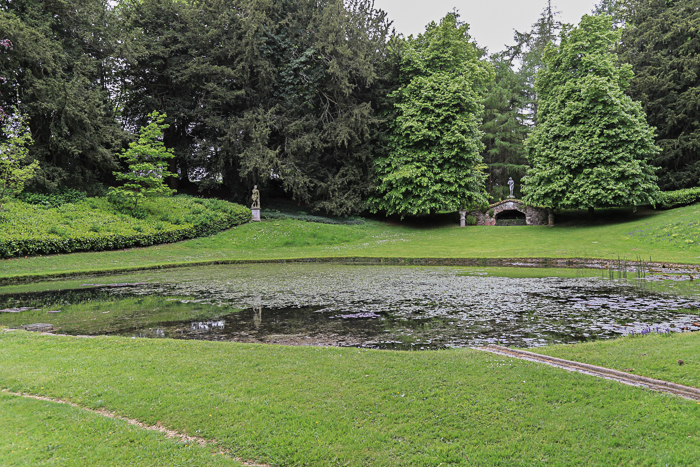
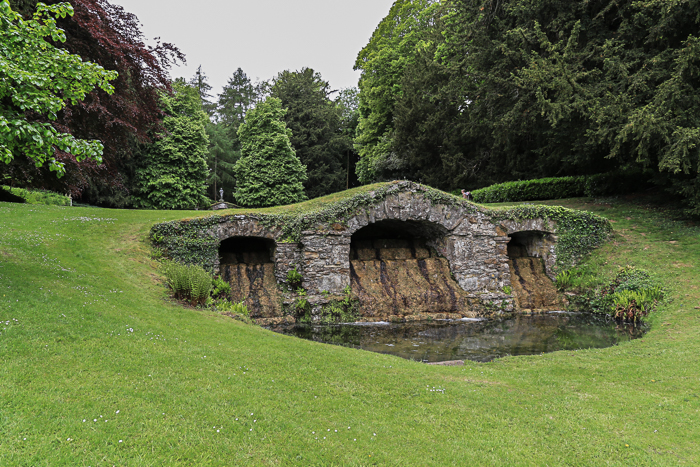
........
Tim Richardson: "Further on ... next to a paddock where handsome Longhorn cattle now graze, is a simple classical gateway flanked by statues which was the public entrance to the garden. Just to one side of it is a castellated Gothick seat--a deliberate act of architectural disorientation by Kent, juxtaposing the classical with the Gothick in this way. Perhaps here, at the garden's boundary, it was imagined that Roman nymphs might cavort with English elves."
Again, Kent uses technique, in this case a ha ha, to create the illusion of an open walk to Rousham House, then prevents that walk and forces the garden visitor to search out another way. He plays with the ideas of openness and closure, making a game of it. Life sometimes becomes play at Rousham. You are forced to slow down, give in to pleasure, contemplation, stillness. Possibly to think about the light and the shade, and wonder what meaning they have, if any. Or to think about mortality. If you go directly around a wide circle on the most direct route to the house, you will encounter this statue of a dying gladiator.
Or to think about mortality. If you go directly around a wide circle on the most direct route to the house, you will encounter this statue of a dying gladiator.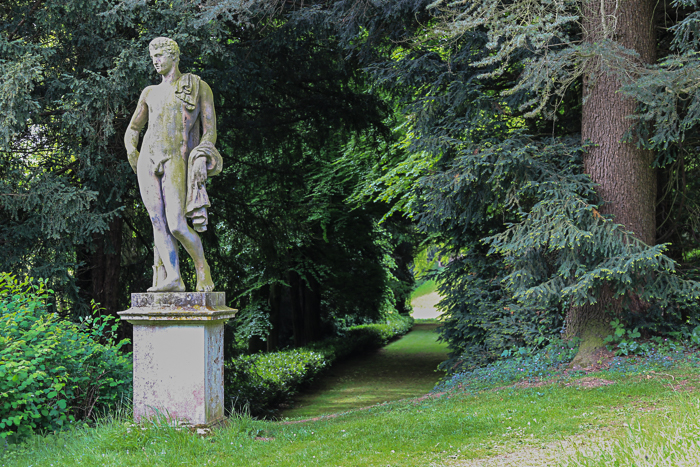 Or go deeper into the garden and come upon this statue of Apollo. You'll probably first see it from a distance, through the long, green corridor behind him. Everywhere you're reminded that the civilization that made Rousham is the equal of the golden age of Augustus, not in Italy of the Romans, but in England's green and pleasant land.
Or go deeper into the garden and come upon this statue of Apollo. You'll probably first see it from a distance, through the long, green corridor behind him. Everywhere you're reminded that the civilization that made Rousham is the equal of the golden age of Augustus, not in Italy of the Romans, but in England's green and pleasant land.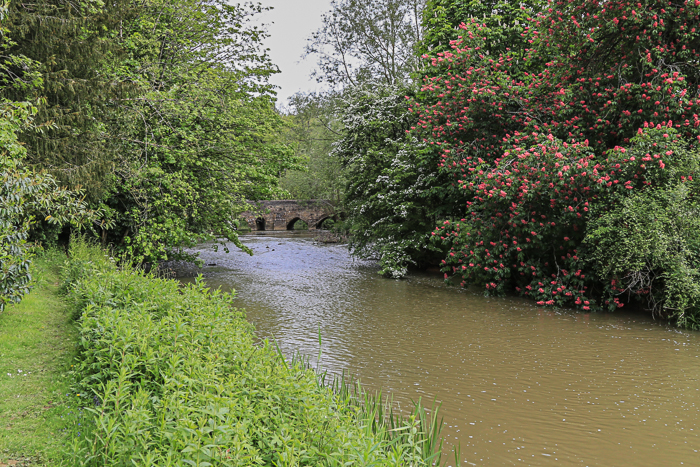 Go further, and find the River Cherwell ...
Go further, and find the River Cherwell ... ... and in the distance, the 1255 Heyford bridge.
... and in the distance, the 1255 Heyford bridge.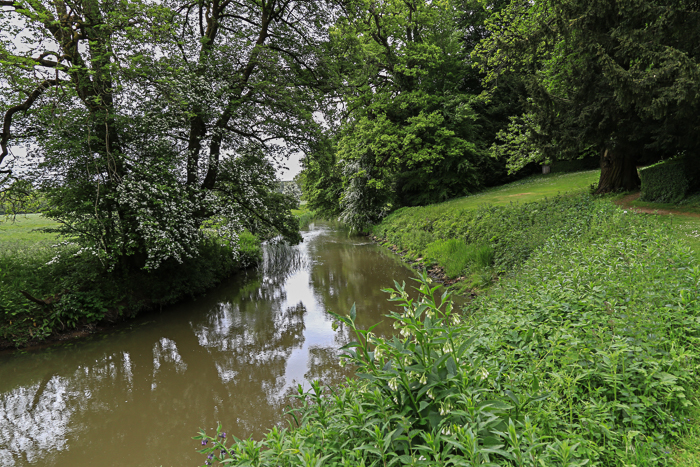
 Walking back up to Rousham House, this path leads between the backside of the great hedge and the walled garden, which dates to a much earlier period. The main entry to the walled garden is through the great hedge.
Walking back up to Rousham House, this path leads between the backside of the great hedge and the walled garden, which dates to a much earlier period. The main entry to the walled garden is through the great hedge. Dan Pearson: "The walled gardens, which sit privately behind the volume of the hedge, are vast and only partially gardened. There are two areas and the smaller of the two is where most of the produce is grown today. The walls are made from brick, in pattern, and overlaid by centuries of lichen..."
Dan Pearson: "The walled gardens, which sit privately behind the volume of the hedge, are vast and only partially gardened. There are two areas and the smaller of the two is where most of the produce is grown today. The walls are made from brick, in pattern, and overlaid by centuries of lichen..."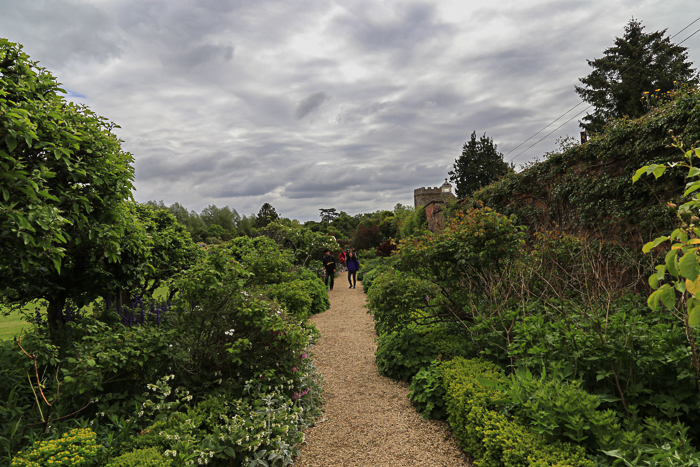 "A Gothic arch in a box hedge, smelling catty but of gardens, leads you to steps up into an orchard around the dovecote. A well-trained cherry wraps the curving walls of the dovecote to the north side and a pear catches the warmth where it falls to the south."
"A Gothic arch in a box hedge, smelling catty but of gardens, leads you to steps up into an orchard around the dovecote. A well-trained cherry wraps the curving walls of the dovecote to the north side and a pear catches the warmth where it falls to the south."
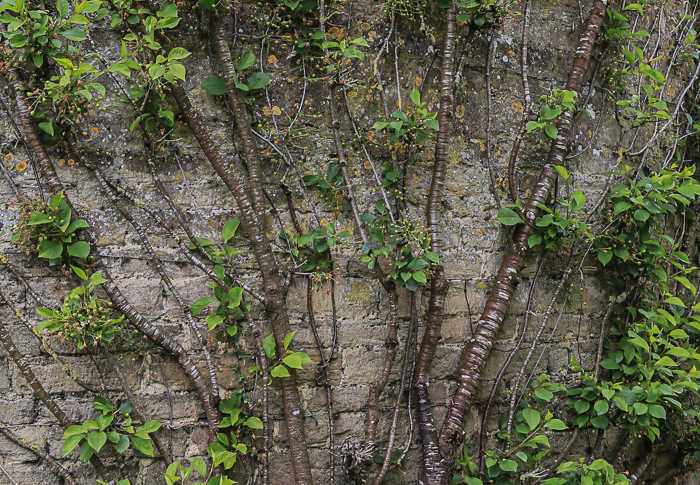 The dovecote was a source of food when originally built ...
The dovecote was a source of food when originally built ... ... and it's located in a 17th century garden parterre, in a style popular long before Kent came to Rousham.At this point our Dutch guide Hans came in search of me. It seems I was the last to leave the garden more than one time.
... and it's located in a 17th century garden parterre, in a style popular long before Kent came to Rousham.At this point our Dutch guide Hans came in search of me. It seems I was the last to leave the garden more than one time.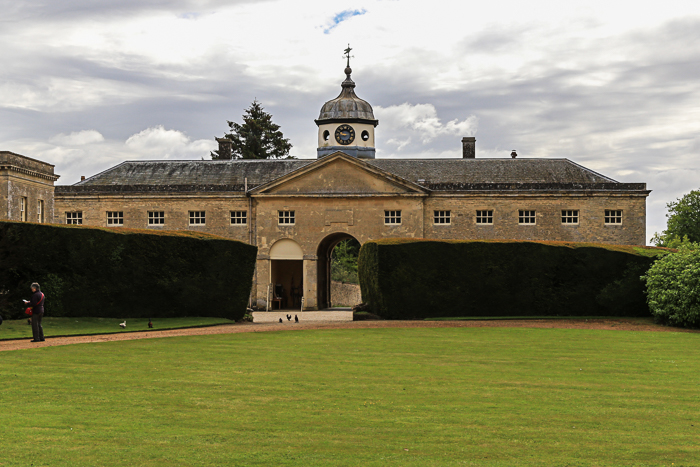 As we departed, we got a good view of the Longhorn cattle that make Rousham their home. This is still a working farm.
As we departed, we got a good view of the Longhorn cattle that make Rousham their home. This is still a working farm. Tim Richardson: " And so we emerge blinking and transfigured after our tour of Rousham garden. Kent can be considered the greatest individual exponent of the landscape garden because he clearly had the ability to visualize the entire garden in his head before he started working, just as a great composer might with a symphony. It was Kent alone who devised a landscape style that set the standard for all subsequent garden-makers; it was Kent who successfully blurred the edges of the landscape-garden structure to inject a true sense of mystery and poise ... Kent's visual genius meant he was able not only to design remarkable architectural caprices, but also to take a tone or atmosphere and imbue it through a garden by moulding physical space and by creating complementary rhythms. He understood that a garden works as a progression through spaces as much as it does from static viewpoints. In terms of its planting, and also in the dynamism of its structure and ornamentation, a landscape garden was, for Kent, a living thing."
Tim Richardson: " And so we emerge blinking and transfigured after our tour of Rousham garden. Kent can be considered the greatest individual exponent of the landscape garden because he clearly had the ability to visualize the entire garden in his head before he started working, just as a great composer might with a symphony. It was Kent alone who devised a landscape style that set the standard for all subsequent garden-makers; it was Kent who successfully blurred the edges of the landscape-garden structure to inject a true sense of mystery and poise ... Kent's visual genius meant he was able not only to design remarkable architectural caprices, but also to take a tone or atmosphere and imbue it through a garden by moulding physical space and by creating complementary rhythms. He understood that a garden works as a progression through spaces as much as it does from static viewpoints. In terms of its planting, and also in the dynamism of its structure and ornamentation, a landscape garden was, for Kent, a living thing."



